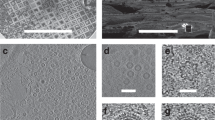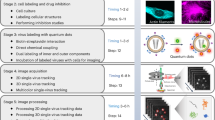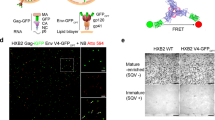Abstract
Observations of individual virions in live cells have led to the characterization of their attachment, entry and intracellular transport1. However, the assembly of individual virions has never been observed in real time. Insights into this process have come primarily from biochemical analyses of populations of virions or from microscopic studies of fixed infected cells. Thus, some assembly properties, such as kinetics and location, are either unknown or controversial2,3,4,5. Here we describe quantitatively the genesis of individual virions in real time, from initiation of assembly to budding and release. We studied fluorescently tagged derivatives of Gag, the major structural component of HIV-1—which is sufficient to drive the assembly of virus-like particles6—with the use of fluorescence resonance energy transfer, fluorescence recovery after photobleaching and total-internal-reflection fluorescent microscopy in living cells. Virions appeared individually at the plasma membrane, their assembly rate accelerated as Gag protein accumulated in cells, and typically 5–6 min was required to complete the assembly of a single virion. These approaches allow a previously unobserved view of the genesis of individual virions and the determination of parameters of viral assembly that are inaccessible with conventional techniques.
This is a preview of subscription content, access via your institution
Access options
Subscribe to this journal
Receive 51 print issues and online access
$199.00 per year
only $3.90 per issue
Buy this article
- Purchase on Springer Link
- Instant access to full article PDF
Prices may be subject to local taxes which are calculated during checkout




Similar content being viewed by others
References
Brandenburg, B. & Zhuang, X. Virus trafficking—learning from single-virus tracking. Nature Rev. Microbiol. 5, 197–208 (2007)
Pelchen-Matthews, A., Kramer, B. & Marsh, M. Infectious HIV-1 assembles in late endosomes in primary macrophages. J. Cell Biol. 162, 443–455 (2003)
Sherer, N. M. et al. Visualization of retroviral replication in living cells reveals budding into multivesicular bodies. Traffic 4, 785–801 (2003)
Jouvenet, N. et al. Plasma membrane is the site of productive HIV-1 particle assembly. PLoS Biol. 4, e435 (2006)
Welsch, S. et al. HIV-1 buds predominantly at the plasma membrane of primary human macrophages. PLoS Pathogens 3, e36 (2007)
Gottlinger, H. G. The HIV-1 assembly machine. AIDS 15 (Suppl. 5). S13–S20 (2001)
Larson, D. R., Johnson, M. C., Webb, W. W. & Vogt, V. M. Visualization of retrovirus budding with correlated light and electron microscopy. Proc. Natl Acad. Sci. USA 102, 15453–15458 (2005)
Jaiswal, J. K. & Simon, S. M. Imaging single events at the cell membrane. Nature Chem. Biol. 3, 92–98 (2007)
Neil, S. J., Eastman, S. W., Jouvenet, N. & Bieniasz, P. D. HIV-1 Vpu promotes release and prevents endocytosis of nascent retrovirus particles from the plasma membrane. PLoS Pathogens 2, e39 (2006)
Neil, S. J., Sandrin, V., Sundquist, W. & Bieniasz, P. D. An interferon-α-induced tethering mechanism inhibits HIV-1 and Ebola virus particle release but is counteracted by the HIV-1 Vpu protein. Cell Host Microbe 2, 193–203 (2007)
Neil, S. J., Zang, T. & Bieniasz, P. D. Tetherin inhibits retrovirus release and is antagonized by HIV-1 Vpu. Nature 451, 425–430 (2008)
Finzi, A., Orthwein, A., Mercier, J. & Cohen, E. A. Productive human immunodeficiency virus type 1 assembly takes place at the plasma membrane. J. Virol. 81, 7476–7490 (2007)
Jaiswal, J. K., Andrews, N. W. & Simon, S. M. Membrane proximal lysosomes are the major vesicles responsible for calcium-dependent exocytosis in nonsecretory cells. J. Cell Biol. 159, 625–635 (2002)
Keyel, P. A., Watkins, S. C. & Traub, L. M. Endocytic adaptor molecules reveal an endosomal population of clathrin by total internal reflection fluorescence microscopy. J. Biol. Chem. 279, 13190–13204 (2004)
Rappoport, J. Z., Taha, B. W. & Simon, S. M. Movement of plasma-membrane-associated clathrin spots along the microtubule cytoskeleton. Traffic 4, 460–467 (2003)
Derdowski, A., Ding, L. & Spearman, P. A novel fluorescence resonance energy transfer assay demonstrates that the human immunodeficiency virus type 1 Pr55Gag I domain mediates Gag–Gag interactions. J. Virol. 78, 1230–1242 (2004)
Hubner, W. et al. Sequence of human immunodeficiency virus type 1 (HIV-1) Gag localization and oligomerization monitored with live confocal imaging of a replication-competent, fluorescently tagged HIV-1. J. Virol. 81, 12596–12607 (2007)
Larson, D. R., Ma, Y. M., Vogt, V. M. & Webb, W. W. Direct measurement of Gag–Gag interaction during retrovirus assembly with FRET and fluorescence correlation spectroscopy. J. Cell Biol. 162, 1233–1244 (2003)
Tramier, M., Zahid, M., Mevel, J. C., Masse, M. J. & Coppey-Moisan, M. Sensitivity of CFP/YFP and GFP/mCherry pairs to donor photobleaching on FRET determination by fluorescence lifetime imaging microscopy in living cells. Microsc. Res. Tech. 69, 933–939 (2006)
Briggs, J. A. et al. The stoichiometry of Gag protein in HIV-1. Nature Struct. Mol. Biol. 11, 672–675 (2004)
Pornillos, O., Garrus, J. E. & Sundquist, W. I. Mechanisms of enveloped RNA virus budding. Trends Cell Biol. 12, 569–579 (2002)
Miesenbock, G., De Angelis, D. A. & Rothman, J. E. Visualizing secretion and synaptic transmission with pH-sensitive green fluorescent proteins. Nature 394, 192–195 (1998)
Simon, S., Roy, D. & Schindler, M. Intracellular pH and the control of multidrug resistance. Proc. Natl Acad. Sci. USA 91, 1128–1132 (1994)
Bieniasz, P. D. Late budding domains and host proteins in enveloped virus release. Virology 344, 55–63 (2006)
Perez-Caballero, D., Hatziioannou, T., Martin-Serrano, J. & Bieniasz, P. D. Human immunodeficiency virus type 1 matrix inhibits and confers cooperativity on gag precursor–membrane interactions. J. Virol. 78, 9560–9563 (2004)
Pedelacq, J. D., Cabantous, S., Tran, T., Terwilliger, T. C. & Waldo, G. S. Engineering and characterization of a superfolder green fluorescent protein. Nature Biotechnol. 24, 79–88 (2006)
Shaner, N. C., Steinbach, P. A. & Tsien, R. Y. A guide to choosing fluorescent proteins. Nature Methods 2, 905–909 (2005)
Acknowledgements
We thank T. Zang for sharing the HeLa cell line stably expressing DsRed–clathrin light chain; A. Baraff for statistical analysis; members of the Bieniasz and Simon laboratories for discussions; and R. Y. Tsien, T. Kirchhausen and G. Miesenböck for plasmids. This work was supported by grants from the National Institutes of Health (to P.D.B. and S.M.S.) and the National Science Foundation (to S.M.S.). N.J. is supported by an amfAR Mathilde Krim Fellowship in Basic Biomedical Research.
Author information
Authors and Affiliations
Corresponding authors
Supplementary information
Supplementary Information
This file contains Supplementary Figures 1-8 with Legends and Supplementary Methods. (PDF 1591 kb)
Supplementary Movie 1
This file contains Supplementary Movie 1. Cell expressing a 1:1 mixture of Gag and Gag-GFP, illustrating the transition from a diffuse to a punctate Gag distribution, observed over a 40 minute period. The movie was acquired at 1 frame every 5 sec, as described in ‘Materials and Methods’ and displayed at a rate of 30 frames/sec. (MOV 7194 kb)
Supplementary Movie 2
This file contains Supplementary Movie 2. Example of 3 individual slowly appearing Gag puncta from a cell expressing a mixture of Gag and Gag-GFP observed for 40 min. The field of observation is 5.5x5.5μm. The movie was acquired at 1 frame every 5 sec, as described in ‘Materials and Methods’ and displayed at a rate of 30 frames/sec. (MOV 15738 kb)
Supplementary Movie 3
This file contains Supplementary Movie 3. An example of a rapidly appearing/disappearing Gag punctum in a cell expressing a mixture of Gag and Gag-GFP observed for 10 minutes. The field of observation is 5.5x5.5μm. The movie was acquired at 1 frame every 5 sec, as described in ‘Materials and Methods’ and displayed at a rate of 30 frames/sec. (MOV 7168 kb)
Supplementary Movie 4
This file contains Supplementary Movie 4. Appearance of Gag puncta in a cell stably expressing CD63-mCherry (red) and transiently expressing Gag and Gag-GFP (green), observed over a 40-minute period. The movie was acquired at 1 frame every 5 sec, as described in ‘Materials and Methods’ and displayed at a rate of 30 frames/sec. (MOV 10308 kb)
Supplementary Movie 5
This file contains Supplementary Movie 5. Examples of rapidly appearing/disappearing Gag puncta in a cell stably expressing CD63-mCherry (red) and transiently expressing Gag and Gag-GFP (green) observed for 10 minutes. The field of observation is 5.5x5.5μm. The movie was acquired at 1 frame every 5 sec, as described in ‘Materials and Methods’ and displayed at a rate of 15 frames/sec. (MOV 4284 kb)
Supplementary Movie 6
This file contains Supplementary Movie 6. Examples of a rapidly appearing/disappearing Gag puncta in a cell stably expressing DsRed-clathrin-light-chain (red) and transiently expressing Gag and Gag-GFP (green) observed over a 5 minute period. The field of observation is 5.5x5.5μm. The movie was acquired at 1 frame every 5 sec, as described in ‘Materials and Methods’ and displayed at a rate of 15 frames/sec. (MOV 3995 kb)
Supplementary Movie 7
This file contains Supplementary Movie 7. Example of a slowly appearing Gag punctum in a cell stably expressing CD63-mCherry (red) and transiently expressing Gag and Gag-GFP (green) imaged over 30 minutes. The field of observation is 5.5x5.5μm. The movie was acquired at 1 frame every 5 sec, as described in ‘Materials and Methods’ and displayed at a rate of 30 frames/sec. (MOV 12698 kb)
Supplementary Movie 8
This file contains Supplementary Movie 8. Example of a slowly appearing Gag punctum in a cell stably expressing DsRed-clathrin-light-chain (red) and transiently expressing Gag and Gag-GFP (green) observed over 15 minutes. The field of observation is 5.5x5.5μm. The movie was acquired at 1 frame every 5 sec, as described in ‘Materials and Methods’ and displayed at a rate of 30 frames/sec. (MOV 3375 kb)
Supplementary Movie 9
This file contains Supplementary Movie 9. Cells expressing Gag and Gag-GFP imaged for a total of 28 minutes. The top cell is the control, non-bleached cell. The bottom cell was bleached for 2 minutes after a 5-minute imaging period and observed for 20 additional minutes after the bleach. The movie was acquired at 1 frame every 5 sec, as described in ‘Materials and Methods’ and displayed at a rate of 30 frames/sec. (MOV 6666 kb)
Supplementary Movie 10
This file contains Supplementary Movie 10. View of a portion of a cell imaged for 5 minutes, bleached for 2 minutes and then observed for 20 additional minutes, illustrating both VLPs that recover after the bleach and VLPs that do not. The field of observation is 5.5x5.5μm. The movie was acquired at 1 frame every 5 sec, as described in ‘Materials and Methods’ and displayed at a rate of 30 frames/sec. (MOV 8363 kb)
Rights and permissions
About this article
Cite this article
Jouvenet, N., Bieniasz, P. & Simon, S. Imaging the biogenesis of individual HIV-1 virions in live cells. Nature 454, 236–240 (2008). https://doi.org/10.1038/nature06998
Received:
Accepted:
Published:
Issue Date:
DOI: https://doi.org/10.1038/nature06998
This article is cited by
-
HIV-1 diverts cortical actin for particle assembly and release
Nature Communications (2023)
-
Broadly neutralizing anti-HIV-1 antibodies tether viral particles at the surface of infected cells
Nature Communications (2022)
-
Biophysical approaches promote understanding of the viral replication cycle
Journal of the Korean Physical Society (2021)
-
Overexpressed coiled-coil domain containing protein 8 (CCDC8) mediates newly synthesized HIV-1 Gag lysosomal degradation
Scientific Reports (2020)
-
Correlative iPALM and SEM resolves virus cavity and Gag lattice defects in HIV virions
European Biophysics Journal (2019)
Comments
By submitting a comment you agree to abide by our Terms and Community Guidelines. If you find something abusive or that does not comply with our terms or guidelines please flag it as inappropriate.



